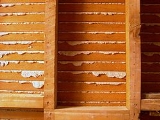
Lath
Encyclopedia

Metal
A metal , is an element, compound, or alloy that is a good conductor of both electricity and heat. Metals are usually malleable and shiny, that is they reflect most of incident light...
or gypsum
Gypsum
Gypsum is a very soft sulfate mineral composed of calcium sulfate dihydrate, with the chemical formula CaSO4·2H2O. It is found in alabaster, a decorative stone used in Ancient Egypt. It is the second softest mineral on the Mohs Hardness Scale...
. A lattice, or lattice-work, is a criss-crossed or interlaced arrangement of laths, or the pattern made by such an arrangement. Lath is the basic material used in the formerly common building technique known as lath and plaster
Lath and plaster
Lath and plaster is a building process used mainly for interior walls in Canada and the United States until the late 1950s. After the 1950s, drywall began to replace the lath and plaster process in the United States. In the United Kingdom, lath and plaster was used for some interior partition...
, which was used to make interior walls.
Lath may also refer to wire mesh, typically with a paper backing, that is applied to a wood or metal framework as matrix over which stucco
Stucco
Stucco or render is a material made of an aggregate, a binder, and water. Stucco is applied wet and hardens to a very dense solid. It is used as decorative coating for walls and ceilings and as a sculptural and artistic material in architecture...
is applied. One of the key elements of lath, whether wooden slats or wire mesh, are the openings or gaps that allow plaster or stucco to ooze behind and form a stronger bond to the lath itself.
Name
The word stems from Old English laett, Mid. Eng. laþþe, a form possibly due to the Welsh liath; the word appears in many Teutonic languages, e.g. Dutch lat, German Latte, and has passed into Romanic, cf. Italian latta, French latte), denoting a thin, flat strip made of wood or possibly another material.Uses
Today, wooden-slat laths are still used in building construction to form a base or groundwork for plasterPlaster
Plaster is a building material used for coating walls and ceilings. Plaster starts as a dry powder similar to mortar or cement and like those materials it is mixed with water to form a paste which liberates heat and then hardens. Unlike mortar and cement, plaster remains quite soft after setting,...
(modern lath and plaster
Lath and plaster
Lath and plaster is a building process used mainly for interior walls in Canada and the United States until the late 1950s. After the 1950s, drywall began to replace the lath and plaster process in the United States. In the United Kingdom, lath and plaster was used for some interior partition...
applications are mostly limited to conservation projects), tile
Tile
A tile is a manufactured piece of hard-wearing material such as ceramic, stone, metal, or even glass. Tiles are generally used for covering roofs, floors, walls, showers, or other objects such as tabletops...
s, slate
Slate
Slate is a fine-grained, foliated, homogeneous metamorphic rock derived from an original shale-type sedimentary rock composed of clay or volcanic ash through low-grade regional metamorphism. The result is a foliated rock in which the foliation may not correspond to the original sedimentary layering...
s, and other coverings, e.g. roof
Roof
A roof is the covering on the uppermost part of a building. A roof protects the building and its contents from the effects of weather. Structures that require roofs range from a letter box to a cathedral or stadium, dwellings being the most numerous....
ing. Such strips of wood are also employed to form lattice-work, or are used as the bars of venetian blinds or shutters.
Riven lath is the stronger forerunner to sawn lath, as it was traditionally split with the grain from chestnut, oak, or similar hardwoods. Laths were also used to fix reed to a timber structure before plastering.
Wire-mesh lath is used extensively with stucco in home and commercial construction. In these applications the lath adds strength and rigidity in addition to providing a matrix to which the stucco can adhere. (This is similar to the way rebar is used to strengthen some concrete and masonry appications.)
Lath cut from spruce or balsam fir trees are used for building wooden lobster traps.
Historical significance

Lath and plaster
Lath and plaster is a building process used mainly for interior walls in Canada and the United States until the late 1950s. After the 1950s, drywall began to replace the lath and plaster process in the United States. In the United Kingdom, lath and plaster was used for some interior partition...
method's popularity declined in the 1950s, as it was replaced by the more efficient drywall
Drywall
Drywall, also known as plasterboard, wallboard or gypsum board is a panel made of gypsum plaster pressed between two thick sheets of paper...
.
See also
- Garden trellisGarden trellisA garden trellis is a structure used to support plants, either by tying the plants to the trellis or by allowing climbing plants to bind themselves to the structure. A trellis can be made of horizontal, vertical, or diagonal bars, usually spaced and arranged to form a decorative structure. The...
- Lathart
- Lattice truss bridge
- Plasterwork#Laths

